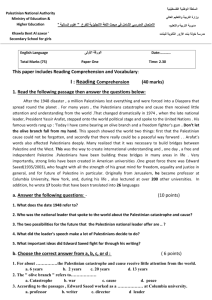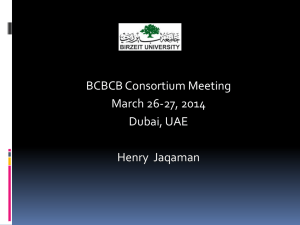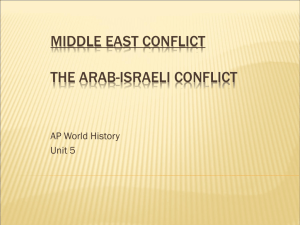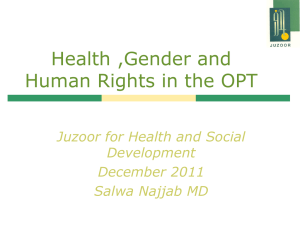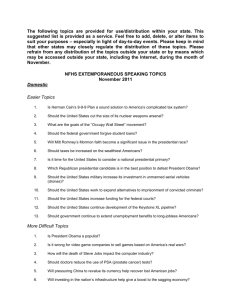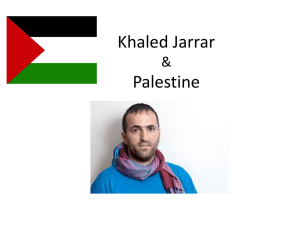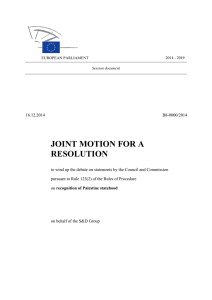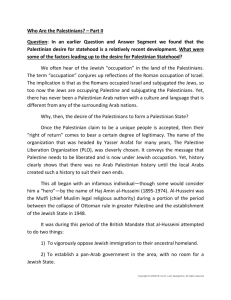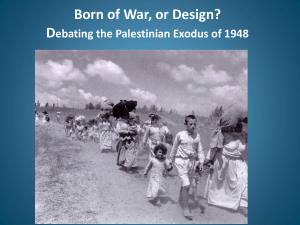palestinian_americans
advertisement
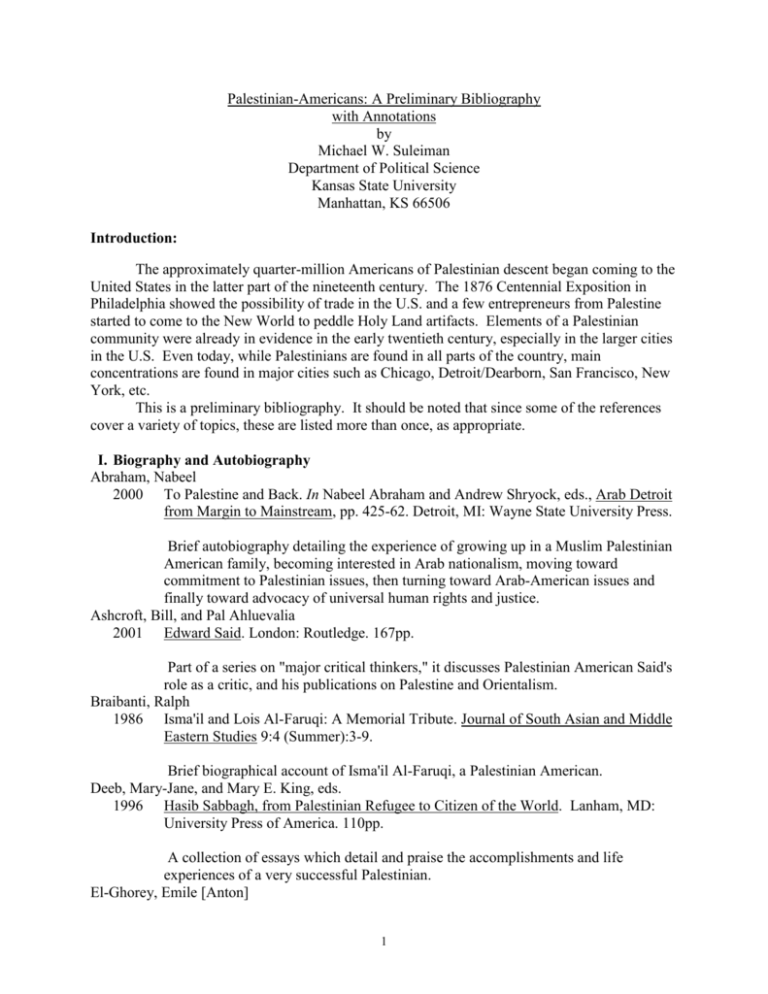
Palestinian-Americans: A Preliminary Bibliography with Annotations by Michael W. Suleiman Department of Political Science Kansas State University Manhattan, KS 66506 Introduction: The approximately quarter-million Americans of Palestinian descent began coming to the United States in the latter part of the nineteenth century. The 1876 Centennial Exposition in Philadelphia showed the possibility of trade in the U.S. and a few entrepreneurs from Palestine started to come to the New World to peddle Holy Land artifacts. Elements of a Palestinian community were already in evidence in the early twentieth century, especially in the larger cities in the U.S. Even today, while Palestinians are found in all parts of the country, main concentrations are found in major cities such as Chicago, Detroit/Dearborn, San Francisco, New York, etc. This is a preliminary bibliography. It should be noted that since some of the references cover a variety of topics, these are listed more than once, as appropriate. I. Biography and Autobiography Abraham, Nabeel 2000 To Palestine and Back. In Nabeel Abraham and Andrew Shryock, eds., Arab Detroit from Margin to Mainstream, pp. 425-62. Detroit, MI: Wayne State University Press. Brief autobiography detailing the experience of growing up in a Muslim Palestinian American family, becoming interested in Arab nationalism, moving toward commitment to Palestinian issues, then turning toward Arab-American issues and finally toward advocacy of universal human rights and justice. Ashcroft, Bill, and Pal Ahluevalia 2001 Edward Said. London: Routledge. 167pp. Part of a series on "major critical thinkers," it discusses Palestinian American Said's role as a critic, and his publications on Palestine and Orientalism. Braibanti, Ralph 1986 Isma'il and Lois Al-Faruqi: A Memorial Tribute. Journal of South Asian and Middle Eastern Studies 9:4 (Summer):3-9. Brief biographical account of Isma'il Al-Faruqi, a Palestinian American. Deeb, Mary-Jane, and Mary E. King, eds. 1996 Hasib Sabbagh, from Palestinian Refugee to Citizen of the World. Lanham, MD: University Press of America. 110pp. A collection of essays which detail and praise the accomplishments and life experiences of a very successful Palestinian. El-Ghorey, Emile [Anton] 1 1973 Filastin abr sittin 'aaman (Palestine Over a 60-Year Period). 2 vols. Beirut: Dar alNahar. 253 & 222 pp. (In Arabic). Includes an account of author's student days in U.S. (1929-1933) and his fundraising trip to U.S. Hall, Loretta 2000 Arab American Voices. Detroit, MI: U.X.L. 233pp. Brief notes and biographies of Arab Americans who express concerns about Palestine, among other issues. Hammad, Suheir 1996 Drops of This Story. New York: Harlem River Press. 93 pp. Wonderful autobiography of a young Palestinian American growing up in Brooklyn, and enduring much poverty, sexism, and racism. Hassan, Ibrahim 1980 From Palestine, 1922. In Joan Morrison and Charlotte Fox Zabusky, eds., American Mosaic: The Immigrant Experience in the Words of Those Who Lived It, pp. 82-84. New York: E.P. Dutton. Short autobiography of a Palestinian American. Hefley, James, and Marti Hefley 1975 The Liberated Palestinian: The Anis Shorrosh Story. Wheaton, IL: Victor Books. 172 pp. Biography of a Palestinian-American evangelist. Holliday, Laurel 1998 Children of Israel, Children of Palestine: Our Own True Stories. New York: Pocket Books. 358 pp. Includes the poignant personal autobiographical stories of children of eight Palestinian Americans at the time of the Nakba (catastrophe) and the founding of the state of Israel. Howar, Barbara 1973 Laughing All the Way. New York: Stein and Day. 298 pp. This non-memoir about the author's life in Washington, DC reports briefly about her husband, Ed Howar, a Palestinian American. Hundley, Tom 1987 Arab Americans: In the Shadow of Prejudice. Detroit Free Press, 6 July, pp. 1A, 6A. Compares the extensive and sympathetic official and media treatment of Leon Klinghoffer's killing with the almost ignored killing of Alex Odeh. Both were terrorist killings. Klinghoffer was a Jewish American, Odeh a Palestinian American. Lynd, Staughton, and Sam Bahour 2 1994 Homeland: Oral Histories of Palestine and Palestinians. New York: Olive Branch Press. 310pp. Includes oral histories of/by Palestinian Americans. Naff, Thomas, ed. 1993 Paths to the Middle East: Ten Scholars Look Back. Albany: State Univ. of New York Press. 360pp. Includes a brief biography of Farhat Ziadeh (Palestinian American). Ryon, Ruth 1983 "Gamble by San Diego Home Builder Pays Off." Los Angeles Times, Part VIII, 3 April, pp. 2,6. Siddiqui, Ataullah 1999 Ismail Raji al-Faruqi: From 'Uruba to Ummatic Concerns. American Journal of Islamic Social Sciences 16:3 (Fall 1999):1-26. Discusses Palestinian American al-Faruqi's transformation from having an Arab nationalist orientation to Islam. Sweeney, Harry A., Jr. 1987 A. Joseph Howar: The Life of Mohammed Issa Abu Al-Hawa (c. 1879-1982). Washington, DC: The Howar Family. 133 pp. Fascinating biography of one of the most successful Palestinian Americans, including his early struggle to overcome poverty, travel to America, facing many almost daunting challenges, only to emerge as a prominent businessman and civic leader in his adopted country's capital. Success story of Palestinian-American businessman Tawfiq Khoury. Said, Edward W. 1999 Out of Place: A Memoir. New York: Alfred A. Knopf. 295pp. Autobiography of the early years of this outstanding Palestinian-American intellectual. A sensitive portrayal of exile, giving expression to what it means to be multi-cultural, especially as a Palestinian in the latter half of the twentieth century. Toubbeh, Jamil I. 1998 Day of the Long Night: A Palestinian Refugee Remembers the Nakba. Jefferson, NC: McFarland & Co. 178pp. Memories of the 1948 loss of Palestine by a Palestinian American also include some political activism in the U.S. for a better understanding of the Palestine issue. Turki, Fawaz 1972 The Disinherited: Journal of a Palestinian Exile. New York: Monthly Review Press. 156pp. Autobiography depicting the early experiences in the Arab world of this Palestinian American. 3 1988 Soul in Exile: Lives of a Palestinian Revolutionary. New York: Monthly Review Press. 204pp. Includes references to the Palestinian community in the U.S. Exile's Return: The Making of a Palestinian American. New York: The Free Press. 274pp. Ziadeh, Farhat 1993 Winds Blow Where Ships Do Not Wish to Go. In Thomas Naff, ed., Paths to the Middle East: Ten Scholars Look Back, pp. 293-324. Albany: State University of New York Press. 1994 Includes the author's experiences as an activist Palestinian-American citizen, especially covering Palestinian issues. II. Community Studies 1. Surveys/General Carpenter, Niles 1927 Immigrants and Their Children, 1920. Washington, D.C.: U.S. Government Printing Office. 431pp. Contains statistics and other facts about Arab Americans, including those from Palestine. Christison, Kathleen 1988 Palestinian Americans Lament Life in Exile. Christian Science Monitor, 14 Oct., pp. 3-4. 1988 1989 Presents feelings of deprivation and frustration by Palestinians in exile in the U.S., exacerbated by the American media's biased coverage Uprising Captivates Palestinians in U.S. Christian Science Monitor, 21 Oct, pp. 3-4. Intifada on West Bank and Gaza revived "flagging Palestinian nationalism" in U.S. Large Palestinian communities are in Detroit (the largest), San Francisco, Los Angeles, Houston, New York and Chicago. The American Experience: Palestinians in the U.S. Journal of Palestine Studies 18(4):18-36. The approximately 200,000 Palestinians in the U.S. are discussed with a focus on assimilation and alienation. Discrimination and prejudice are present but not strongly felt. Unlike other immigrant groups, second generation does not reject parents' ethnicity. Haddad, Samir A. 1983 "The Shift in Field Dependence/Independence of Jordanian Children after Living in the United States." Ed.D. diss. Wayne State University: Detroit, MI. 135pp. 4 Uses field dependence/independence measures to investigate the cognitive style of Jordanian and Palestinian elementary school students, some living in Jordan, others in the United States (Detroit, Michigan). Hammoudo, Ahmed A. 1980 Jordanian Emigration: An Analysis of Migration Data. International Migration Review 14:3 (Fall):357-382. Includes references to Jordanian/Palestinian immigrants to the United States and Canada. Harik, Iliya 1986 The Palestinians in the Diaspora. In Gabriel Sheffer, ed., Modern Diasporas in International Politics, pp. 315-32. London: Croom Helm. Brief reference to Palestinians in the U.S. Hassoun, Rosina [Jean] 1997 Palestinians. In David Levinson and Melvin Ember, eds., American Immigrant Cultures: Builders of a Nation, pp. 678-684. New York: Simon and Schuster Macmillan. Brief survey of Palestinian immigrants, their families, women, arts, culture, health issues, identity, and discrimination against them. Hazu, Tuma Wadi 1982 "The Effect of Cultural Affinity on Language Dominance of Arab Minority Students in Selected American Public Schools." Ph.D. diss., Florida State Univ. 117pp. Investigates the relationship between cultural affinity and language dominance of elementary school Arab-American (including Palestinian) students in Wayne County, Michigan who were enrolled in the bilingual education program. Hutchinson, E.P. 1956 Immigrants and Their Children, 1850-1950. New York: John Wiley & Sons. 391pp. Includes references to "Arab Palestine." Jordan, E.L. 1949 From Foreign Lands. Informative Classroom Picture Publishers. Brief references to Palestinians. Klee, Kathleen Garnett Bombyk 1993 "Self-Esteem and Language Achievement among Arab Adults Studying English as a Second Language." Ph.D. diss., University of Southern Mississippi. 227pp. 1994 Subjects included Arabs from Palestine residing in the Dearborn/Detroit, Michigan area. Investigates relationship between language achievement and self-esteem. Self-Esteem among Arab Adults: Studying English as a Second Language. Michigan Journal of Counseling and Development 22:2(Spring):27-32. 5 Investigates relationship between English language learning and self-esteem among Palestinians and other Arabs. MacClarin, Wanda J. 1979[?] "The Palestinian Community in San Francisco." Master's thesis, Univ. of California, Berkeley. 62 pp. Discusses the causes of immigration, identity maintenance, occupations, women, attitudes on U.S. and Palestine, political activity, and FBI harassment. Orfalea, Gregory 1988 Before the Flames: A Quest for the History of Arab Americans. Austin, TX: University of Texas Press. 354pp. Includes numerous references to Palestine and Palestinians. Turki, Fawaz 1988 Soul in Exile: Lives of a Palestinian Revolutionary. New York: Monthly Review Press. 204pp. Includes references to the Palestinian community in the U.S. 1A. Demography/Emigration/Immigration/Professions/Education Adawi, Jamal Nayif 1993 Al-Hijra al-Filastiniyah ila Amrika min nihayat al-qarn al-tasi'-ashar hatta aam 1945 (Palestinian Emigration to America from the End of the Nineteenth Century until 1945). Nazareth, Israel: Al-Matba'a al-sha'biyah. 199pp. Details the history of Palestinian immigration to the Americas, focusing on the causes of the various waves of emigration. Al-Tahir, Abdul Jalil 1952 "The Arab Community in the Chicago Area: A Comparative Study of the ChristianSyrians and the Muslim-Palestinians." Ph.D. diss., University of Chicago. 234pp. Excellent early study of Chicago Muslim Palestinians, their migration, location, spatial mobility, newspapers, organizations, occupations, family and social institutions and their isolation, marginality, and attempts at assimilation. Cohen, Yinon, and Andrea Tyree 1994 Palestinian and Jewish Israeli-Born Immigrants in the United States. International Migration Review 28:2 (Summer):243-55. Based on parts of the 1980 U.S. Census, it finds that over 30% of Israeli-born Americans are Palestinian Arabs who seem to constitute a Middleman Minority in grocery stores. Hajar, Paula M. 1993 "Arab Immigrant Parents and American Schoolpeople: An Ethnography of a CrossCultural Relationship." D. Ed. diss., Harvard University. 461pp. Studies the relationship between Arab-American parents ( including those from Palestine) and school personnel. 6 Himadeh, Sa'id B. 1938 Economic Organization of Palestine. Beirut: American Press. 602pp. Provides figures for Palestinians in the United States in 1922. Hussaini, Hatem I. 1974 The Impact of the Arab-Israeli Conflict on Arab Communities in the United States. In Ibrahim Abu-Lughod and Baha Abu-Laban, eds., Settler Regimes in Africa and the Arab World: The Illusion of Endurance, pp. 201-20. Wilmette, IL: Medina University Press International. Argues that the 1967 Arab-Israeli war "had a significant, but not a decisive impact" on Arab Americans. Discusses American government agencies' harassment of Arab Americans in order to discourage debate on the Palestine issue. Jaafari, Lafi Ibrahim 1971 "Migration of Palestinian Arab and Jordanian Students and Professionals to the United States." Ph.D. diss., Iowa State Univ. 137pp. 1973 Survey questionnaire found that Palestinian migration and settlement in the U.S. was for career advancement, better work and professional environment. The Brain Drain to the United States: The Immigration of Jordanian and Palestinian Professionals and Students. Journal of Palestine Studies 3:1 (Autumn):119-31. In a survey of Palestinian and Jordanian students in the U.S., various reasons were provided for staying in the U.S. Kazaleh, Fadwa Ann 1986 "Biculturalism and Adjustment: A Study of Ramallah-American Adolescents in Jacksonville, Florida." Ph.D. diss. Florida State Univ. 235pp. Provides a detailed overview of the Eastern Orthodox Christian Ramallah-American community in Jacksonville, Florida, studies the experiences of youths, difficulties of acculturation/assimilation, especially for girls, and the different mechanisms of behavior control and coping. Kurson, Ken 1995 Palestinian Americans. In Anna Sheets, Judy Galens, and Robyn V. Young, eds., Gale Encyclopedia of Multicultural America, vol. 2, pp. 1042-54. New York: Gale Research, Inc. Covers history, acculturation/assimilation, cuisine, clothing, language, family, religion, occupations, and political activity. Mansour, Riyad 1980 The Palestinian Community in the United States of America: Its Present Status and Development Horizons. Al-Thawri, Special Issue, no. 20 (Jan.):1-72. 1980 Demographic statistics about Palestinian Americans, based on data from the annual reports of the U.S. Immigration and Naturalization Service. Tables, maps. The Palestinian Community in the United States. Shu'un Filastiniyah 100:66-87. 7 Demographic statistics of Palestinian Americans. Oschinsky, Lawrence 1947 "Islam in Chicago: Being a Study of the Acculturation of a Muslim-Palestinian Community in That City." Master's Thesis. Chicago, IL: University of Chicago. 67pp. Covers Muslim Palestinian migration to Chicago and the social and economic conditions of the community. Finds that Muslim Palestinians emphasized their ethnicity. Appendices present the village and family origins of immigrants. Razin, Eran, and Ivan Light 1998 Ethnic Enterpreneurs in America's Largest Metropolitan Areas. Urban Affairs Review 33:3 (Jan.):332-360. Includes references to immigrants from Palestine/Israel. Roof, Michael K., and Kevin G. Kinsella 1985 Palestinian Population. Washington, DC: Center for International Research, U.S. Bureau of the Census. 164pp. Bureau of the Census estimated that 72,600 Palestinians were in the U.S. in 1981 (p. 150). Seikaly, May 1999 Attachment and Identity: The Palestinian Community of Detroit. In Michael W. Suleiman, ed., Arabs in America: Building a New Future, pp. 25-38. Philadelphia, PA: Temple University Press. Deals with Detroit-area Palestinian Americans, providing background information, the impact of wars in Palestine on the Palestinians in the U.S., their notion of identity, and their reaction to frequent disasters in the former homeland. Shaath, Nabeel 1972 High Level Palestinian Manpower. Journal of Palestine Studies 1:2 (Winter):80-95. Includes references to Palestinians in the U.S. Younis, Adele Linda 1961 "The Coming of the Arabic-Speaking People to the United States." Ph.D. diss., Boston University. 364pp. One of the earliest and most thorough historical studies of Arab (including Palestinian) immigration into the United States. Zaghel, Ali Shteiwi 1976 "Changing Patterns of Identification among Arab-Americans: The Palestinian Ramallites and the Christian Syrian-Lebanese." Ph.D. diss., Northwestern Univ. 459pp. Excellent study of Arab Americans (Palestinian Ramallites and Christian Syrian- 8 Lebanese) in Chicago in the 1960s and 1970s to investigate their changing patterns of ethnic identification (de-assimilation), as a result of the impact of the 1967 and 1973 Mid-East wars and the hostile American environment in which they live. Constitutions/by-laws of Ramallah American Club. 1B. Identity/Culture Hammoud, Mahmoud Mohammad 1992 "The Role of Communication in the Preservation of National and Cultural Identity of a Nation in Exile: The Palestinian Case." Ph.D. diss. Ohio University. 421pp. The strong sense of Palestinian identity among Palestinian Americans was found to be greatly re-inforced by the Palestinian-oriented media. Exposure to U.S. media had a negative impact. Hood, Kathleen Ann 1998 "Music, Spirituality, and Cultural Identity: The Liturgy of the Antiochian Orthodox Church in Los Angeles." Master's thesis, University of California, Los Angeles. 103pp. Explores the role of liturgical music in the presentation of the spiritual and cultural identity of Orthodox Christian Arab Americans (including those of Palestinian background) in Los Angeles. Hopper, May Harboush 1983 "Comparative Analysis of Ethnic Identity, Self Concept and Attitudes Toward Women Among Lebanese and Palestinians." Ph.D. diss., Univ. of Florida. 151pp. Investigates the relationship between ethnic and social variables on one had and selfconcept and attitudes toward women's roles and behaviors on the other. Najjar, Rima 1994 A Palestinian's Struggle with Cultural Conflicts. In Jill M. Bystydzienski and Estelle P. Resnik, eds., Women in Cross-Cultural Transitions, pp. 39-44. Bloomington, IN: Phi Delta Kappa Educational Foundation. Author reflects on various issues causing cultural conflicts for her and her family. Nye, Naomi Shihab 1996 Never in a Hurry: Essays on People and Places. Columbia, SC: Univ. of South Carolina Press. 253pp. Beautifully written book of essays by a Palestinian-American poet who covers many aspects of her life and experiences as a product of two cultures. Shammas, Anton 1991 Amerka, Amerka: A Palestinian Abroad in the Land of the Free. Harper's, Feb., pp. 55-61. A Palestinian in America reflects on homelessness, immigration, American stereotypes of Palestine and Palestinians -- and the way America is able to accommodate newcomers, including ones with "portable homelands" (p. 61). 9 2002 Autocartography: The Case of Palestine, Michigan. Palestine-Israel Journal 9(2):111-119. Deals with the issue of identity, especially for Palestinians in America. 1C. Attitudes on Palestine Ashcroft, Bill, and Pal Ahluevalia 2001 Edward Said. London: Routledge. 167pp. Part of a series on "major critical thinkers," it discusses Palestinian American Said's role as a critic, and his publications on Palestine and Orientalism. Barghouti, Iyad 1989 Palestinian Americans: Socio-Political Attitudes of Palestinian Americans Towards the Arab-Israeli Conflict. Durham, UK: Centre for Near Eastern & Islamic Studies, University of Durham. 66pp. Through a survey questionnaire, it seeks to identify the factors impacting the attitudes of Palestinian Americans toward the Arab-Israeli conflict. Christison, Kathleen 1988 Uprising Captivates Palestinians in U.S. Christian Science Monitor, 21 Oct, pp. 3-4. Intifada on West Bank and Gaza revived "flagging Palestinian nationalism" in U.S. Large Palestinian communities are in Detroit (the largest), San Francisco, Los Angeles, Houston, New York and Chicago. Holliday, Laurel 1998 Children of Israel, Children of Palestine: Our Own True Stories. New York: Pocket Books. 358 pp. Includes the poignant personal autobiographical stories of children of eight Palestinian Americans at the time of the Nakba (catastrophe) and the founding of the state of Israel. Lynd, Staughton, and Sam Bahour 1994 Homeland: Oral Histories of Palestine and Palestinians. New York: Olive Branch Press. 310pp. Includes oral histories of/by Palestinian Americans. MacClarin, Wanda J. 1979 Arabs Like U.S., but There's No Place Like Home. San Francisco Examiner, 10 Oct., A2. 1979 Express longing for a Palestinian homeland. Picture. The "Poor" Arabs Send Money Back to Homeland. San Francisco Examiner, 17 Oct., p. A2. Palestinians in San Francisco help their relatives back home. Picture. Moughrabi, Fouad, and Pat El-Nazer 10 1989 What Do Palestinian Americans Think? Results of a Public Opinion Survey. Journal of Palestine Studies 18:4 (Summer):91-101. Studies the attitudes of Palestinian Americans toward PLO leadership, how to settle the Palestinian-Israeli problem, aspirations for the future, and the potential role of the U.S. Naughton, Jim 1988 The Emerging Voices of the Palestinians. Washington Post, 7 June, pp. D1, D4. Interviews with some Palestinian Americans and their discussions on Palestine. Nye, Naomi Shihab 1982 "Local Hospitality." Stories 2:47-55. 1984 Palestinian American visits relatives in Palestine and writes about their hospitality. "One Village." Journal of Palestine Studies 13:2 (Winter):31-47. 1997 On a visit to her grandmother's village, Nye describes the life of people in Palestine and the hardships suffered under Israeli occupation. Habibi. New York: Simon and Schuster. 259pp. 1997 Semi-autobiographical novel, meant for young readers, of the experiences of a Palestinian-American young girl who goes to live in Jerusalem with her relatives. Double Vision in a New Old World. In Thomas Cooley, ed., The Norton Sampler: Short Essays for Composition, 5th ed, pp. 289-98. New York: W.W. Norton. Nye reminisces about and reflects on life in Palestine and in the U.S. Pousner, Michael, and Frank Faso 1970 A Dream of Palestine Grows in Brooklyn. (New York) Daily News, 10 Nov, p. 78. Discusses Palestinian Americans, who are overwhelmingly Muslim, work in bluecollar jobs and are passionate about Palestine. Said, Edward W. 1994 Representations of the Intellectual. New York: Pantheon Books. 121 pp. Text of the six Reith Lectures delivered by the foremost Palestinian-American intellectual, on the British Broadcasting Corporation radio network (BBC) in which modern intellectuals are criticized for often lacking the courage or integrity to voice critical views on important societal issues, such as the treatment of Palestinians. Schur, Roberta 1988 Palestine Lives Quietly in Arab-Americans' Hearts. Christian Science Monitor, 15 March, pp.1,6. Reports on Palestinian Americans' positive and supportive stance toward the intifada. At an ADC conference, Arab Americans express concern about Israeli policies and inadequate American press coverage of the Palestinian-Israeli conflict. 11 1D. Ramallah Aswad, Barbara C., ed. 1974 Arabic Speaking Communities in American Cities. New York: Center for Migration Studies and AAUG. 191 pp. Surveys several Arab-American communities, mostly in Michigan, including those immigrants from Ramallah, Palestine. Ghannam, Jeffrey 2000 Hope, Figs, and a Place Called Home. In Nabeel Abraham and Andrew Shryock, eds., Arab Detroit from Margin to Mainstream, pp. 463-69. Detroit, MI: Wayne State University Press. Memoir reminiscing about Ghannam's former hometown of Ramallah, Palestine. Kassees, Assad Saied 1970 "The People of Ramallah: A People of Christian Arab Heritage." Ph.D. diss. Florida State Univ. 199pp. Studies the value changes in the changing culture of the Ramallah (Palestine) Christian immigrants to the United States resulting in a greater emphasis on their original identity, heritage and cultural background. Kassees, Assad S. 1972 Cross-Cultural Comparative Familism of a Christian Arab People. Journal of Marriage and the Family 34(3):538-44. Based on interviews with Ramallah people in Ramallah and the U.S. Those in the U.S. were found to be more familistic than their counterparts in Ramallah. Kazaleh, Fadwa Ann 1986 "Biculturalism and Adjustment: A Study of Ramallah-American Adolescents in Jacksonville, Florida." Ph.D. diss. Florida State Univ. 235pp. Provides a detailed overview of the Eastern Orthodox Christian Ramallah-American community in Jacksonville, Florida, studies the experiences of youths, difficulties of acculturation/assimilation, especially for girls, and the different mechanisms of behavior control and coping. Kenny, Keith Dallas 1993 "Language Loss and Hesitation Frequency: The Case of Ramallawi Arabic in Detroit." Ph.D. diss., Univ. of Michigan. 219pp. Investigates the relationship between hesitation frequency and length of stay in U.S. among Ramallah, Palestine immigrants in the Detroit, Michigan area. Saba, Leila 1971 "The Social Assimilation of the Ramallah Community Residing in Detroit." Master's thesis. Wayne State Univ. 182pp. Descriptive study of the Detroit Ramallah community finds many similarities between its members and the host society. They have not completely assimilated 12 because of strong kinship and family ties as well as affection and concern for their former homeland in Palestine. Shaheen, Azeez 1982 Ramallah: Its History and Its Genealogies. Birzeit: Birzeit Univ. 807 pp. in Arabic + 77 pp. in English. History, genealogy, family trees of the people of Ramallah, large numbers of whom immigrated to the U.S. Shihadeh, Boulus 1911 A Word to Ramallah [Palestine] Immigrants in the Mahjar. Meraat-ul-Gharb, 3 March, p.4. Urges the approximately 800 immigrants from Ramallah in the U.S. to avoid divisiveness and to form social and charitable organizations. Swan, Charles L., and Leila B. Saba 1974 The Migration of a Minority. In Barbara C. Aswad, ed., Arabic Speaking Communities in American Cities, pp.85-110. New York: Center for Migration Studies and AAUG. Study of the acculturation and assimilation of the Christian Ramallah, Palestine community (especially male heads of households) in Detroit, Michigan. Zaghel, Ali Shteiwi 1976 "Changing Patterns of Identification among Arab-Americans: The Palestinian Ramallites and the Christian Syrian-Lebanese." Ph.D. diss., Northwestern Univ. 459pp. Excellent study of Arab Americans (Palestinian Ramallites and Christian SyrianLebanese) in Chicago in the 1960s and 1970s to investigate their changing patterns of ethnic identification (de-assimilation), as a result of the impact of the 1967 and 1973 Mid-East wars and the hostile American environment in which they live. Constitutions/by-laws of Ramallah American Club. 1E. Bir Zeit Alloush, Musa 1991 Immigrants. Bir-Zeit, Palestine: Bir-Zeit Library. 100pp in English + 62pp in Arabic. Background and family histories of emigrants from Bir-Zeit to the Americas, including the U.S. Family genealogies. Stockton, Ronald R. 1985 The Palestinians of Dearborn, Michigan. Psychological Reports 56:123-129. Finds that Palestinians in Dearborn view themselves as in exile, rather than as immigrants -- an orientation that impacts their behavior and attitudes. III. Religion 1. Christians Hefley, James, and Marti Hefley 13 1975 The Liberated Palestinian: The Anis Shorrosh Story. Wheaton, IL: Victor Books. 172 pp. Biography of a Palestinian-American evangelist. Hood, Kathleen Ann 1998 "Music, Spirituality, and Cultural Identity: The Liturgy of the Antiochian Orthodox Church in Los Angeles." Master's thesis, University of California, Los Angeles. 103pp. Explores the role of liturgical music in the presentation of the spiritual and cultural identity of Orthodox Christian Arab Americans (including those of Palestinian background) in Los Angeles. Kazaleh, Fadwa Ann 1986 "Biculturalism and Adjustment: A Study of Ramallah-American Adolescents in Jacksonville, Florida." Ph.D. diss. Florida State Univ. 235pp. Provides a detailed overview of the Eastern Orthodox Christian Ramallah-American community in Jacksonville, Florida, studies the experiences of youths, difficulties of acculturation/assimilation, especially for girls, and the different mechanisms of behavior control and coping. Swan, Charles L., and Leila B. Saba 1974 The Migration of a Minority. In Barbara C. Aswad, ed., Arabic Speaking Communities in American Cities, pp.85-110. New York: Center for Migration Studies and AAUG. Study of the acculturation and assimilation of the Christian Ramallah, Palestine community (especially male heads of households) in Detroit, Michigan. 2. Muslims Al-Tahir, Abdul Jalil 1952 "The Arab Community in the Chicago Area: A Comparative Study of the ChristianSyrians and the Muslim-Palestinians." Ph.D. diss., University of Chicago. 234pp. Excellent early study of Chicago Muslim Palestinians, their migration, location, spatial mobility, newspapers, organizations, occupations, family and social institutions and their isolation, marginality, and attempts at assimilation. Cainkar, Louise 1988 "Palestinian Women in the United States: Coping with Tradition, Change, and Alienation." Ph.D. diss., Northwestern University, Evanston, IL. 251 pp. This well-crafted study deals with Palestinian-American women, especially in Chicago, in a socio-political context of statelessness, involuntary emigration, U.S. government harassment and anti-Arab racism, and a hostile U.S. foreign policy on Palestine. Discusses the life and beliefs of Palestinian-American women who view their statelessness as a major factor in the gender inequality they experience. 14 1990 1991 1994 Palestinian Women in the United States: Who Are They and What Kind of Lives Do They Lead? In Images and Reality: Palestinian Women under Occupation and in the Diaspora, pp. 55-66. Washington, DC: Institute for Arab Women's Studies. Palestinian-American women suffer from alienation in American society which discriminates against Palestinans. Author differentiates among four varieties of Palestinian women based on immigration patterns and family contact. Palestinian-American Muslim Women: Living on the Margins of Two Worlds. In Earle H. Waugh, Sharon McIrvin Abu-Laban, and Regula Burckhardt Qureshi, eds., Muslim Families in North America, pp. 282-308. Edmonton, Alberta, Canada: University of Alberta Press. Studies Palestinian women growing up in U.S., feeling isolated and marginal, and encountering difficulties finding Palestinian male partners. Younger and older women cohorts face difficult problems. Palestinian Women in American Society: The Interaction of Social Class, Culture, and Politics. In Ernest McCarus, ed., The Development of Arab-American Identity, pp. 85-105. Ann Arbor, MI: University of Michigan Press. Discusses the role of class and culture in the value orientations and behavior of Palestinian Muslim women in the Unites States. Oschinsky, Lawrence 1947 "Islam in Chicago: Being a Study of the Acculturation of a Muslim-Palestinian Community in That City." Master's Thesis. Chicago, IL: University of Chicago. 67pp. Covers Muslim Palestinian migration to Chicago and the social and economic conditions of the community. Finds that Muslim Palestinians emphasized their ethnicity. Appendices present the village and family origins of immigrants. Pousner, Michael, and Frank Faso 1970 A Dream of Palestine Grows in Brooklyn. (New York) Daily News, 10 Nov, p. 78. Discusses Palestinian Americans, who are overwhelmingly Muslim, work in bluecollar jobs and are passionate about Palestine. Sabbagh, Suha, and Ghada Talhami, eds. 1990 Images and Reality: Palestinian Women under Occupation and in the Diaspora. Washington, DC: Institute for Arab Women's Studies. 66pp. Contains an article on Palestinian women in the U.S. Syriani, Mohammad M. 1977 "Residential Distribution, Spatial Mobility, and Acculturation in an Arab-Muslim Community." Ph.D. diss., Michigan State Univ., Lansing, MI. 196pp. Deals with Muslim Arab (including Palestinian) migration to the U.S., their residential patterns in the Dearborn/Detroit area, their spatial mobility, and their 15 acculturation. Concludes that they are restrained form mobility by lack of knowledge of English, by societal discrimination, and by a feeling of inferiority. Waugh, Earle H., Sharon McIrvin Abu-Laban, and Regula Burckhardt Qureshi, eds. 1991 Muslim Families in North America. Edmonton, Alberta, Canada: University of Alberta Press. 369pp. Includes a study of Palestinian Muslim women in the U.S. Wigle, Laurel D. 1974 An Arab-Muslim Community in Michigan. In Barbara C. Aswad, ed., Arabic Speaking Communities in American Cities, pp. 155-167. Staten Island, NY: Center for Migration Studies and AAUG. Provides history and socio-economic background of the Arab (including Palestinian) Muslim community in Detroit and their cultural preservation. IV. Palestinians in American Cities 1. Chicago Al-Tahir, Abdul Jalil 1952 "The Arab Community in the Chicago Area: A Comparative Study of the ChristianSyrians and the Muslim-Palestinians." Ph.D. diss., University of Chicago. 234pp. Excellent early study of Chicago Muslim Palestinians, their migration, location, spatial mobility, newspapers, organizations, occupations, family and social institutions and their isolation, marginality, and attempts at assimilation. City of Chicago 1976 The People of Chicago: Who We Are and Who We Have Been. Chicago, IL: City of Chicago Department of Development and Planning. 76pp. Includes data on Chicago Arab groups, including Palestinians. Oschinsky, Lawrence 1947 "Islam in Chicago: Being a Study of the Acculturation of a Muslim-Palestinian Community in That City." Master's Thesis. Chicago, IL: University of Chicago. 67pp. Covers Muslim Palestinian migration to Chicago and the social and economic conditions of the community. Finds that Muslim Palestinians emphasized their ethnicity. Appendices present the village and family origins of immigrants. 2. Detroit/Dearborn Alomari, Suha Raouf Suliman 1978 "The Impact of Cultural Milieus upon Vocational Maturity: A Comparative Study of the Career Maturity of Junior High School Students of Arabic and Non-Arabic Backgrounds." Ph.D. diss., Wayne State Univ. 244pp. Investigates the relationship between career maturity of Arab students (including those from Palestine) in Salina Junior High School (South End of Dearborn, 16 Michigan) and the ethnic background, grade in school, gender, religious affiliation, parents' length of residence in the U.S., father's occupation, education, etc. Klee, Kathleen Garnett Bombyk 1993 "Self-Esteem and Language Achievement among Arab Adults Studying English as a Second Language." Ph.D. diss., University of Southern Mississippi. 227pp. 1994 Subjects included Arabs from Palestine residing in the Dearborn/Detroit, Michigan area. Investigates relationship between language achievement and self-esteem. Self-Esteem among Arab Adults: Studying English as a Second Language. Michigan Journal of Counseling and Development 22:2(Spring):27-32. Investigates relationship between English language learning and self-esteem among Palestinians and other Arabs. Rankin, Lois 1939 Detroit Nationality Groups. Michigan History Magazine 23 (Spring):129-205. Includes a section on "Syrians," including Palestinians, and covers their early migration, residence in the Detroit area, and religious affiliation. Saba, Leila 1971 "The Social Assimilation of the Ramallah Community Residing in Detroit." Master's thesis. Wayne State Univ. 182pp. Descriptive study of the Detroit Ramallah community finds many similarities between its members and the host society. They have not completely assimilated because of strong kinship and family ties as well as affection and concern for their former homeland in Palestine. Seikaly, May 1999 Attachment and Identity: The Palestinian Community of Detroit. In Michael W. Suleiman, ed., Arabs in America: Building a New Future, pp. 25-38. Philadelphia, PA: Temple University Press. Deals with Detroit-area Palestinian Americans, providing background information, the impact of wars in Palestine on the Palestinians in the U.S., their notion of identity, and their reaction to frequent disasters in the former homeland. Stockton, Ronald R. 1985 The Palestinians of Dearborn, Michigan. Psychological Reports 56:123-129. Finds that Palestinians in Dearborn view themselves as in exile, rather than as immigrants -- an orientation that impacts their behavior and attitudes. Suleiman, Michael W., ed. 1999 Arabs in America: Building a New Future. Philadelphia, PA: Temple University Press. 355pp. Includes a chapter on Palestinians in the Detroit area. Syriani, Mohammad M. 17 1977 "Residential Distribution, Spatial Mobility, and Acculturation in an Arab-Muslim Community." Ph.D. diss., Michigan State Univ., Lansing, MI. 196pp. Deals with Muslim Arab (including Palestinian) migration to the U.S., their residential patterns in the Dearborn/Detroit area, their spatial mobility, and their acculturation. Concludes that they are restrained form mobility by lack of knowledge of English, by societal discrimination, and by a feeling of inferiority. Wigle, Laurel D. 1974 An Arab-Muslim Community in Michigan. In Barbara C. Aswad, ed., Arabic Speaking Communities in American Cities, pp. 155-167. Staten Island, NY: Center for Migration Studies and AAUG. Provides history and socio-economic background of the Arab (including Palestinian) Muslim community in Detroit and their cultural preservation. 3. San Francisco MacClarin, Wanda J. 1979 Arab Refugees Keep the Faith, Mind the Store. San Francisco Examiner, 10 Oct., D2. Discussion of San Francisco Palestinians, their occupations, number (8,000), and families. Picture. MacClarin, Wanda J. 1979[?] "The Palestinian Community in San Francisco." Master's thesis, Univ. of California, Berkeley. 62 pp. Discusses the causes of immigration, identity maintenance, occupations, women, attitudes on U.S. and Palestine, political activity, and FBI harassment. 4. New York/Brooklyn El Farra, Laila 1982 On Palestinians in New York. Christian Science Monitor, 1 Oct., p. 26. Letter to the editor. Husein, Hasan Ibrahim 1986 "Economic, Social and Spatial Mobility: The Case of the Palestinians." Ph.D. diss., City University of New York. 219pp. Analyzes the processes and forces instrumental in the creation and maintenance of the Palestinian ethnic community in New York and New Jersey. Explores the concepts of chain migration, ethnic persistence and adaptation, emphasizing tradition, kinship, and friendship as forces shaping the Palestinian community. Pousner, Michael, and Frank Faso 1970 A Dream of Palestine Grows in Brooklyn. (New York) Daily News, 10 Nov, p. 78. Discusses Palestinian Americans, who are overwhelmingly Muslim, work in bluecollar jobs and are passionate about Palestine. 18 5. Minnesota Miller, Deborah L. 1981 Middle Easterners: Syrians, Lebanese, Armenians, Egyptians, Iranians, Palestinians, Turks, Afghans. In June D. Holmquist, ed., They Chose Minnesota, pp. 511-530. St Paul, MN: Minneapolis Historical Society. Short account of Palestinians in Minnesota, providing statistics, emigration and settlement, professions, religions, acculturation, etc. 6. Columbus, OH Krueger, Nancy Moore 1955 "Assimilation and Adjustment of Postwar Immigrants in Franklin County, Ohio." Ph.D. diss. Ohio State Univ. 130pp. Includes a few references to Palestinians in the Columbus area. V. Palestinian-American Women Abdo, Nahla 1993 Race, Gender and Politics: The Struggle of Arab Women in Canada. In Linda Carty, ed., And Still We Rise: Feminist Political Mobilizing in Contemporary Canada, pp. 73-100. Toronto, Canada: Women's Press. Discusses the many marginalizations of Arabs, especially Palestinian women in North America, particularly Canada. Cainkar, Louise 1988 "Palestinian Women in the United States: Coping with Tradition, Change, and Alienation." Ph.D. diss., Northwestern University, Evanston, IL. 251 pp. 1990 1991 This well-crafted study deals with Palestinian-American women, especially in Chicago, in a socio-political context of statelessness, involuntary emigration, U.S. government harassment and anti-Arab racism, and a hostile U.S. foreign policy on Palestine. Discusses the life and beliefs of Palestinian-American women who view their statelessness as a major factor in the gender inequality they experience. Palestinian Women in the United States: Who Are They and What Kind of Lives Do They Lead? In Images and Reality: Palestinian Women under Occupation and in the Diaspora, pp. 55-66. Washington, DC: Institute for Arab Women's Studies. Palestinian-American women suffer from alienation in American society which discriminates against Palestinans. Author differentiates among four varieties of Palestinian women based on immigration patterns and family contact. Palestinian-American Muslim Women: Living on the Margins of Two Worlds. In Earle H. Waugh, Sharon McIrvin Abu-Laban, and Regula Burckhardt Qureshi, eds., Muslim Families in North America, pp. 282-308. Edmonton, Alberta, Canada: University of Alberta Press. 19 1994 Studies Palestinian women growing up in U.S., feeling isolated and marginal, and encountering difficulties finding Palestinian male partners. Younger and older women cohorts face difficult problems. Palestinian Women in American Society: The Interaction of Social Class, Culture, and Politics. In Ernest McCarus, ed., The Development of Arab-American Identity, pp. 85-105. Ann Arbor, MI: University of Michigan Press. Discusses the role of class and culture in the value orientations and behavior of Palestinian Muslim women in the Unites States. Hopper, May Harboush 1983 "Comparative Analysis of Ethnic Identity, Self Concept and Attitudes Toward Women Among Lebanese and Palestinians." Ph.D. diss., Univ. of Florida. 151pp. Investigates the relationship between ethnic and social variables on one had and selfconcept and attitudes toward women's roles and behaviors on the other. Sabbagh, Suha, and Ghada Talhami, eds. 1990 Images and Reality: Palestinian Women under Occupation and in the Diaspora. Washington, DC: Institute for Arab Women's Studies. 66pp. Contains an article on Palestinian women in the U.S. Shakir, Evelyn 1997 Bint Arab: Arab and Arab American Women in the United States. Westport, CT: Praeger. 226pp. Excellent historical study of Arab-American women, their values, challenges, and attempts at adjusting to culture and life in America which includes views on the Palestine issue. Waugh, Earle H., Sharon McIrvin Abu-Laban, and Regula Burckhardt Qureshi, eds. 1991 Muslim Families in North America. Edmonton, Alberta, Canada: University of Alberta Press. 369pp. Includes a study of Palestinian Muslim women in the U.S. VI. Health Issues Ajalat, Denise Ann 1996 "Arab-American Christian Mothers and the Health Care Received for Their Children." Ph.D. diss., California School of Professional Psychology, Los Angeles. 187pp. Discusses access to health care and Arab (including Palestinian) children in the U.S. Dwairy, Marwan Adeeb 1998 Cross-Cultural Counseling: The Arab-Palestinian Case. New York: Haworth Press. 225pp. Argues that Western psychotherapy needs to be modified/adapted in dealing with Palestinians/Arabs, including Arabs in America. 20 Elsayed, Yousria Ahmed 1986 "The Successive-Unsettled Transitions of Migration and Their Impact on Postpartum Concerns of Arab Immigrant Women." D.N.S. diss., University of California, San Francisco. 175pp. Investigated the impact of migration to the United States on the postpartum concerns of Christian and Muslim Arab-American (including Palestinian) women in the San Francisco Bay Area. Hassoun, Rosina Jean 1995 "A Bioanthropological Perspective of Hypertension in Arab-Americans in the Metropolitan Detroit Area." Ph.D. diss., Univ. of Florida. 413pp. Studies the relationships among activity levels, diet, and obesity levels associated with the acculturation of four Arab-American sub-groups, including Jordanians/Palestinians, in the Metropolitan Detroit area. Hjeij, Naila D. 1993 "Health Beliefs and Frequency and Proficiency of Breast Self-Examination among Arab Women Living in the United States." M.S.N. thesis. Duquesne University School of Nursing. 83pp. Investigates the relationship between the health beliefs of Arab-American (including Palestinian) women and the frequency and efficiency of breast self-examination. Maloof, Patricia Sarah 1979 "Medical Beliefs and Practices of Palestinian-Americans." Ph.D. diss., Catholic Univ. of America. 288pp. Details the medical beliefs, attitudes, and practices of Christian and Muslim Palestinian Americans in the Washington, DC metropolitan area. May, Kathleen M. 1985 "Arab-American Immigrant Parents' Social Networks and Health Care of Children." D.N.S. diss., Univ. of California, San Francisco. 219pp. Studies Arab- (including Palestinian-) American parents' perception of the health care for their children, their health behaviors toward their children, the patterns of help-seeking as well as social networks and support. VII. Literature 1. General Literature Haddad, Yusuf Ayyub 1982 Filastin fi al-adab al-mahjari (Palestine in Emigré Literature). Beirut, Lebanon: Mu'assassat fikr lil-abhath wa-al-nashr. 357pp. Dissusses Palestinie in the poetry of Arab-American literati, especially Iliya AbuMadi, Nasib Arida and Ameen Rihani. Jayyusi, Salma Khadra, ed. 21 1992 Anthology of Modern Palestinian Literature. New York: Columbia University Press. 745pp. Includes poetry and prose (translated from Arabic) by Palestinian-American writers. Among them: Salma Khadra Jayyusi, Anton Shammas, Sharif Elmusa, Lena Jayyusi, Naomi Shihab Nye, Fawaz Turki, and Hisham Sharabi. Orfalea, Gregory 1988 Literary Devolution: The Arab in the Post-World War II Novel in English. Journal of Palestine Studies 17(2):109-28. 1991 Survey of English-language fiction about the Middle East since WWII shows that the overwhelming majority of works are antagonistic to Arabs, especially Palestinians. Leon Uris is the worst offender. Doomed by Our Blood to Care: The Poetry of Naomi Shihab Nye. Paintbrush 18:35 (Spring):56-66. Analysis of themes in Nye's poetry shows her caring for her people, the Palestinians, but also for the people in the Hispanic southwest of the U.S., Latin America and humanity in general. 2. Poetry A. Busailah Busailah, Reja-e 1985 We Are Human Too: Poems on the Palestinian Condition. Wilmette, IL: Medina Press. 66pp. Poetry by an Arab American relating to the Palestine issue. B. Hammad Hammad, Suheir 1996 Born Palestinian, Born Black. New York: Harlem River Press. 99 pp. Poetry book by a Palestinian American which covers many critical issues, including exile, Palestinian suffering, life in a Brooklyn "ghetto," and prejudice. C. Nye Nye, Naomi Shihab 1980 Different Ways to Pray. Portland, OR: Breitenbush Publications. 61pp. 1986 Poetry book by a Palestinian American who writes with humor and grace about issues of cultural diversity, beauty and peace. Yellow Glove. Portland, OR: Breitenbush Books. 85pp. 1994 Poetry book which includes references to the poet's Palestinian-American background. Red Suitcase. Brockport, NY: BOA Editions, Ltd. 107pp. Poetry book which deals with author's Palestinian background. D. Turki 22 Turki, Fawaz 1975 Poems from Exile. Washington, DC: Palestine Press. 68pp. 1978 Powerful poems by a Palestinian American written about Palestinian themes. Tel Zaatar Was the Hill of Thyme. Washington, DC: Free Palestine Press. 68pp. Powerful Poems mostly related to the Palestine tragedy by a Palestinian American. 3. Fiction A. Abu-Jaber Abu-Jaber, Diana 1993 In Flight. Left Bank, no. 5:19-26. 1995 This is an excerpt from a forthcoming novel "Memories of Birth" and describes a family's flight from Palestine during the 1948 Palestinian-Israeli war. My Elizabeth. Kenyon Review 17, no. 1(New Series): pp. 1-14. 1993 Story of the friendship of two teenage girls (one Palestinian American, the other Native American) who find much in common. Arabian Jazz. San Diego: Harcourt Brace. 374 pp. Good novel about a Palestinian/Jordanian-American family. Themes include clash of values, and male/female relationships. B. Baehr Baehr, Consuelo Saah 1988 Daughters. New York: Dell Publishing. 614pp. A novel covering the lives of three generations of Christian Palestinian women, with interludes in the United States. C. Bahous Bahous, Sally 1993 Sitti and the Cats. Longmont, CO: Roberts Rinehart Publishers. 24pp. Children's story about Palestine by an Arab-American writer. VIII. Arab Attitudes toward Palestine Abourezk, James G. Advise and Dissent: Memoirs of South Dakota and the U.S. Senate. Chicago, IL: Lawrence Hill Books. 267pp. Memoirs of the first Arab-American U.S. senator and the founder of the AmericanArab Anti-Discrimination Committee (ADC), including his many run-ins with the Israeli lobby and his attempts to present a more favorable image of Arabs, ArabAmericans, Palestinians, and Lebanese. Abu-Laban, Baha 1990 Social and Political Attitudes of Arab-Americans. Washington, D.C.: ADC. 54 pp. 23 Based on a 1989 questionnaire mailed to all ADC members in the U.S. and Canada. Survey covered opinions on Palestine. Hall, Loretta 2000 Arab American Voices. Detroit, MI: U.X.L. 233pp. Brief notes and biographies of Arab Americans who express concerns about Palestine, among other issues. NAAA (National Association of Arab Americans) 1993 Policy Platform. Washington, DC: NAAA. 20pp. Outlines NAAA policy positions on Palestine and Arab-Israeli conflict. National Association of the Federations of Syrian and Lebanese American Clubs 1959? 1959 Overseas Convention and Pilgrimage in the Middle East. Damascus, U.A.R. 51pp. (In Arabic). Contains speeches of immigrant leaders, their impressions of the Arab homeland as well as Arab causes, including Palestine. New York Times 1951 Truman Gets Arab Plea. 4 Oct., p. 10 Reports about a meeting that the National Association of Syrian and Lebanese American Federations had with President Truman about Palestine. Suleiman, Michael W. 1969 The New Arab-American Community. In Elaine C. Hagopian and Ann Paden, eds., The Arab-Americans: Studies in Assimilation, pp. 37-47. Wilmette, IL: Medina University Press International. 1995 Records views on Palestine and Israel. Palestine and the Palestinians in the Mind of America. In Michael W. Suleiman, ed., U.S. Policy on Palestine from Wilson to Clinton, pp. 9-26. Normal, IL: AAUG Press. Surveys the origin and development of American views of Palestine and the Palestinians as reflected in literature, school textbooks, the press, television, movies, churches and opinion polls. IX. Acculturation/Assimilation Abdo, Nahla 1993 Race, Gender and Politics: The Struggle of Arab Women in Canada. In Linda Carty, ed., And Still We Rise: Feminist Political Mobilizing in Contemporary Canada, pp. 73-100. Toronto, Canada: Women's Press. Discusses the many marginalizations of Arabs, especially Palestinian women in North America, particularly Canada. Abraham, Nabeel 24 2000 To Palestine and Back. In Nabeel Abraham and Andrew Shryock, eds., Arab Detroit from Margin to Mainstream, pp. 425-62. Detroit, MI: Wayne State University Press. Brief autobiography detailing the experience of growing up in a Muslim Palestinian American family, becoming interested in Arab nationalism, moving toward commitment to Palestinian issues, then turning toward Arab-American issues and finally toward advocacy of universal human rights and justice. Al-Tahir, Abdul Jalil 1952 "The Arab Community in the Chicago Area: A Comparative Study of the ChristianSyrians and the Muslim-Palestinians." Ph.D. diss., University of Chicago. 234pp. Excellent early study of Chicago Muslim Palestinians, their migration, location, spatial mobility, newspapers, organizations, occupations, family and social institutions and their isolation, marginality, and attempts at assimilation. Christison, Kathleen 1989 The American Experience: Palestinians in the U.S. Journal of Palestine Studies 18(4):18-36. The approximately 200,000 Palestinians in the U.S. are discussed with a focus on assimilation and alienation. Discrimination and prejudice are present but not strongly felt. Unlike other immigrant groups, second generation does not reject parents' ethnicity. Griffin, Philip J. 1985 The Immigration and Assimilation Patterns within the Arab-American Community. Washington, DC: U.S. Department of State, Foreign Service Institute. 38 pp. Primarily descriptive account of Arabs (including Palestinians)in the Detroit area. Husein, Hasan Ibrahim 1986 "Economic, Social and Spatial Mobility: The Case of the Palestinians." Ph.D. diss., City University of New York. 219pp. Analyzes the processes and forces instrumental in the creation and maintenance of the Palestinian ethnic community in New York and New Jersey. Explores the concepts of chain migration, ethnic persistence and adaptation, emphasizing tradition, kinship, and friendship as forces shaping the Palestinian community. Mehdi, M.T. 1968 Kennedy and Sirhan: Why? New York: New World Press. 100pp. States the case for understanding the circumstances behind the assassination of Robert Kennedy, especially Sirhan Sirhan's (and by extension the Palestinians) history of alienation and injustice. X. Political Activism 1. Individuals Rihani, Ameen 25 1929 Palestine Arabs Claim to Be Fighting for National Existence. Current History 31(2):272-78. Presenting the "Arab" position on Palestine. Soladay, Salwa 1990 My Experience with the Proposition W Campaign. Israel & Palastina, no. 24:27-34. Discusses the failed attempt in San Francisco to pass Proposition W calling for a two-state solution in Palestine. The naivete and lack of political experience of Arab Americans did not help. Terry, Janice J. 1999 Community and Political Activism among Arab Americans in Detroit. In Michael W. Suleiman, ed., Arabs in America: Building a New Future, pp. 241-254. Philadelphia, PA: Temple University Press. Presents a study of activists in the Detroit Arab-American communities who include Palestinians. Toubbeh, Jamil I. 1998 Day of the Long Night: A Palestinian Refugee Remembers the Nakba. Jefferson, NC: McFarland & Co. 178pp. Memories of the 1948 loss of Palestine by a Palestinian American also include some political activism in the U.S. for a better understanding of the Palestine issue. Wingerter, Rex B. 1985 The Palestinian-Israel Conflict in the U.S. Courtroom. Link 18(3):1-13. Reviews cases involving espionage for Israel, extradition of a Palestinian to Israel, government surveillance of activist Arab Americans, tax-deductible contributions to Israel, blacklisting of pro-Arab artists, and dual citizenship. Ziadeh, Farhat 1993 Winds Blow Where Ships Do Not Wish to Go. In Thomas Naff, ed., Paths to the Middle East: Ten Scholars Look Back, pp. 293-324. Albany: State University of New York Press. Includes the author's experiences as an activist Palestinian-American citizen, especially covering Palestinian issues. 2. Organizations Blankfort, Jeffrey 1989 Proposition W. Middle East Report 19(2):38-40. 1990 Discusses the causes for the defeat of Proposition W in San Francisco which called for a two-state (Palestine/Israel) solution. Proposition W and the Pacification of the U.S. Middle East Movement. Israel & Palastina, no. 24:35-55. 26 Discusses the tatics of Middle East peace activists and the possible reasons for the defeat of proposition W. Davidson, Lawrence 1999 Debating Palestine: Arab-American Challenges to Zionism, 1917-1932. In Michael W. Suleiman, ed., Arabs in America: Building a New Future, pp. 227-40. Philadelphia, PA: Temple University Press. Traces the activities of Arab Americans in the early part of the twentieth century in challenging American Zionists over the issue of Palestine. Ernst, Friedhelm, and Paula Kotakis 1990 Perspectives from the Community [Concerning the Proposition W Campaign]: Interviews with Fuad Mugannam and Nidal Totah. Israel & Palastina, no. 24:18-22. Less than one percent of Arab Americans in San Francisco were active in the campaign to pass Proposition W to recommend U.S. support for a Palestinian state. Discusses the politics and support and opposition and reasons for failure. Friedhelm, Ernst, and Paula Kotakis 1990 Proposition W -- San Francisco. Israel & Palastina 24:7-13. (In German). Discusses the attempt to get Proposition W accepted by the San Francisco voters. Institute of Arab American Affairs 1945 Papers on Palestine. New York. Institute of Arab American Affairs, Inc. Collection of articles by a variety of authors supporting the Arab character of Palestine. Khabbaz, Hanna 1919 We Are All Brothers. Al-Sa'ih, 13 Feb., pp.1,2. An address delivered before the Palestinian Society Opposed to Zionism. The message is that Zionism should be opposed but that Christians, Muslims and Jews are all one people who should live in harmony in Palestine. Khalil, Ya'qub Jirjis 1915 The Annual Palestine Welfare Society Party. Meraat-ul-Gharb, 15 Jan., p. 5. Provides names of officers and activists. Malouf, Faris S. 1949 Resolution Urges Justice Toward Palestine. Federation Herald, 25 January, p. 6. Eastern Federation asks U.S. government not to be influenced by Zionist pressures on the UN partition resolution, and to consider justice for Palestinians. McCloskey, Helen H. 1990 Proposition W and the American Electoral System. Israel & Palastina, no. 24:14-17. Discusses how opponents of Proposition W favoring a two state solution in Palestine used obfuscation and confusing language to mislead the public and thus defeat the measure. 27 National Association of the Federations of Syrian and Lebanese American Clubs 1959? 1959 Overseas Convention and Pilgrimage in the Middle East. Damascus, U.A.R. 51pp. (In Arabic). Contains speeches of immigrant leaders, their impressions of the Arab homeland as well as Arab causes, including Palestine. New York Times 1951 Truman Gets Arab Plea. 4 Oct., p. 10 Reports about a meeting that the National Association of Syrian and Lebanese American Federations had with President Truman about Palestine. Palestine & Transjordan 1937 Memorandum of the Arab National League. 6 March, pp. 7,9. Arab National League representatives met with U.S. Secretary of State and presented him with a memorandum outlining their views and suggested policy on Palestine. Shatara, F. I. 1937 The Palestine Question. Palestine & Transjordan, 15 May, pp. 5,7. Author was president of the Arab National League (NY) and argued against political Zionism which would deny the majority Palestinian Arabs their patrimony. Terry, Janice J. 1999 Community and Political Activism among Arab Americans in Detroit. In Michael W. Suleiman, ed., Arabs in America: Building a New Future, pp. 241-254. Philadelphia, PA: Temple University Press. Presents a study of activists in the Detroit Arab-American communities who include Palestinians. Twair, Pat, and Samir Twair 1988 Palestinian Statehood on City-Wide November Ballot. Sada Alwatan, 24-30 Sept., p. 3. (In Arabic). Reports on Arab-American attempt to pass a Palestinian statehood measure, known as Proposition W, in a San Francisco initiative. Wingerter, Rex B. 1985 The Palestinian-Israel Conflict in the U.S. Courtroom. Link 18(3):1-13. Reviews cases involving espionage for Israel, extradition of a Palestinian to Israel, government surveillance of activist Arab Americans, tax-deductible contributions to Israel, blacklisting of pro-Arab artists, and dual citizenship. Ziad Abu Eain Defense Committee [1981?]The Extradition of Ziad Abu Eain: A Dangerous Precedent for Americans. Chicago, IL: Ziad Abu Eain Defense Committee. 25pp. Argues against the extradition of the Palestinian Ziad Abu Eain to Israel. 28 XI. The American Context 1. American Attitudes on Palestine Abu-Laban, Baha, and Faith T. Zeadey, eds. 1975 Arabs in America: Myths and Realities. Wilmette, IL: Medina University Press International. 256 pp. Contains studies on the question of Palestine. Arab Studies Quarterly 1986 Nation-Wide Survey of U.S. Attitudes on the Middle East. Vol. 8:1(Winter):62-68. Reports American attitudes on Palestine. Mallon, Elias D. 1989 Neighbors: Muslims in North America. New York: Friendship Press. 104pp. Attempts to introduce Americans to Muslims as neighbors and colleagues in order to make them less alien and more familiar. Includes an interview with Dawud Assad (Palestinian American). Swedenburg, Ted 1992 Seeing Double: Palestinian/American Histories of the Kufiya. Michigan Quarterly Review 31(4):557-55. Details the history of the Kufiya in Palestine and the U.S. and shows that Americans who began to wear this traditional Palestinian head dress in the mid-1980s did so not because it was fashionable but in sympathy/solidarity with Palestinians. 2. Prejudice/Discrimination Christison, Kathleen 1989 The American Experience: Palestinians in the U.S. Journal of Palestine Studies 18(4):18-36. The approximately 200,000 Palestinians in the U.S. are discussed with a focus on assimilation and alienation. Discrimination and prejudice are present but not strongly felt. Unlike other immigrant groups, second generation does not reject parents' ethnicity. Egan, John P. 1984 An American Testimony from an Israeli Prison: The Case of Mike Mansour. Journal of Palestine Studies 14:1 (Fall):118-125. Details one example of Arab Americans detained without charge by Israel. Fischback, Michael R. 1985 Government Pressures Against Arabs in the United States. Journal of Palestine Studies 14:3 (Spring):87-100. Discusses American surveillance and harassment of Arab Americans, including the extradition case of Ziad Abu Ain. Gabriel, Judith 29 1987 The Los Angeles Deportation Cases. Journal of Palestine Studies 17(1):114-28. Provides a detailed history of the so-called "L.A. 8" case, the INS Contingency Plan, the constitutional challenge and the procedural maneuvers involved. The case had not yet been resolved. Ghannam, Wendy 2001 "Arab American Discrimination in the U.S. Government Workplace and Its Ramifications." Al-Hewar. http://www.com/wendy_ghannam.htm. On April 4, 2001, Ghannam related to Al-Hewar that she experienced discrimination at her work in the U.S. government because she was married to a Palestinian. Hagopian, Elaine 1975/1976 Minority Rights in a Nation State: The Nixon Administration's Campaign Against Arab-Americans. Journal of Palestine Studies 5:1&2 (Autumn/Winter):97114. Provides an account of "Operation Boulder," the Nixon Administration's actions against Arab (including Palestinian) Americans, limiting their activities in the name of state security -- and the reaction of Arab Americans and their organizations to that campaign. Hanania, Ray 1996 I'm Glad I Look Like a Terrorist; Growing up Arab in America: Humor and Reality in the Ethnic American Experience. Tinley Park, IL: Urban Strategies Group. 246 pp. A collection of articles by a Palestinian American which deal with the problems of prejudice and discrimination against Arabs in the United States. Hudson, Brian 1989 Hysteria by Law: The Palestinian Deportation Case and the INS Contingency Plan. Without Prejudice 2(1):40-60. Discusses the harassment of Arab Americans and focuses on the case of the L.A. 8 as well as the 1986 INS Contingency Plan. Hundley, Tom 1987 Arab Americans: In the Shadow of Prejudice. Detroit Free Press, 6 July, pp. 1A, 6A. Compares the extensive and sympathetic official and media treatment of Leon Klinghoffer's killing with the almost ignored killing of Alex Odeh. Both were terrorist killings. Klinghoffer was a Jewish American, Odeh a Palestinian American. Shaheen, Jack G. 1989 Palestinians on the Silver Screen in the 1980's. Arab-American Affairs, no. 28:6880. 30 Ten of eleven movies discussed "show Palestinians as international terrorists" (p. 70). Movies dehumanize Palestinians and present them as the scourge of the 20th century, and drive a wedge between Americans and Palestinians. Shaheen, Jack [G.] 1981 Images of Saudis and Palestinians: A Review of Major Documentaries. In William C. Adams, ed., Television Coverage of the Middle East, pp. 89-105. Norwood, NJ: Ablex. Reviews various American television documentaries on the Palestinians. 3. Governmental Surveillance/Harassment/No protection Abu-Fadil, Magda 1987 Immigration Case Against Palestinians a Bust? Arab American News, 28 Feb - 6 March, p.3. English section. Discusses the arrest and trial of the L.A. - 8, i.e. eight Jordanians/Palestinians in Los Angeles. Hussaini, Hatem I. 1974 The Impact of the Arab-Israeli Conflict on Arab Communities in the United States. In Ibrahim Abu-Lughod and Baha Abu-Laban, eds., Settler Regimes in Africa and the Arab World: The Illusion of Endurance, pp. 201-20. Wilmette, IL: Medina University Press International. Argues that the 1967 Arab-Israeli war "had a significant, but not a decisive impact" on Arab Americans. Discusses American government agencies' harassment of Arab Americans in order to discourage debate on the Palestine issue. 4. Media Abunimah, Ali, and Hussein Ibish 2001 The U.S. Media and the New Intifada. In Roane Carey, ed., The New Intifada: Resisting Israel's Apartheid, pp. 233-256. New York: Verso. Highlights the different ways the media have reported negatively on the Palestinians, and the few examples of good coverage. 31
